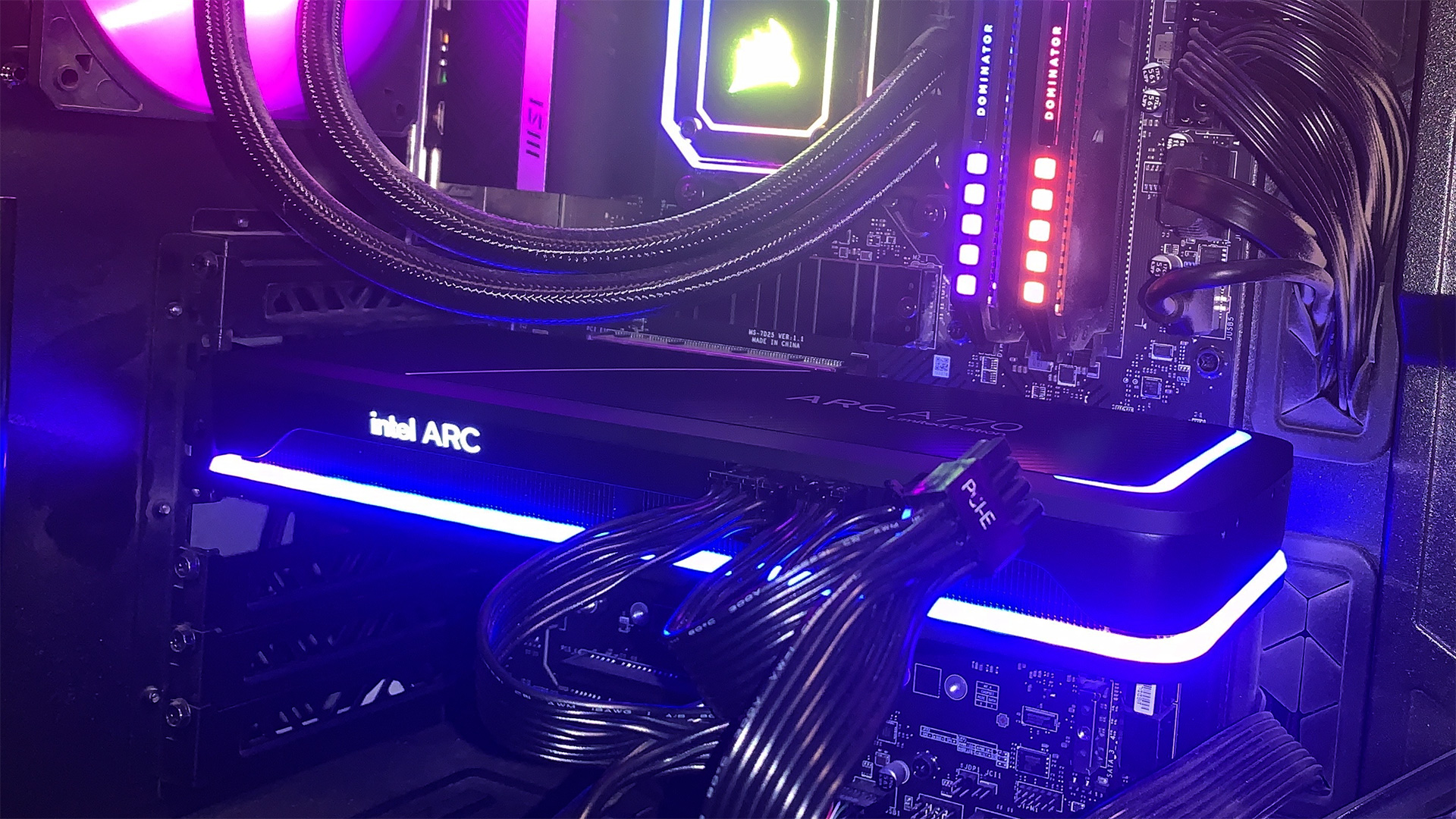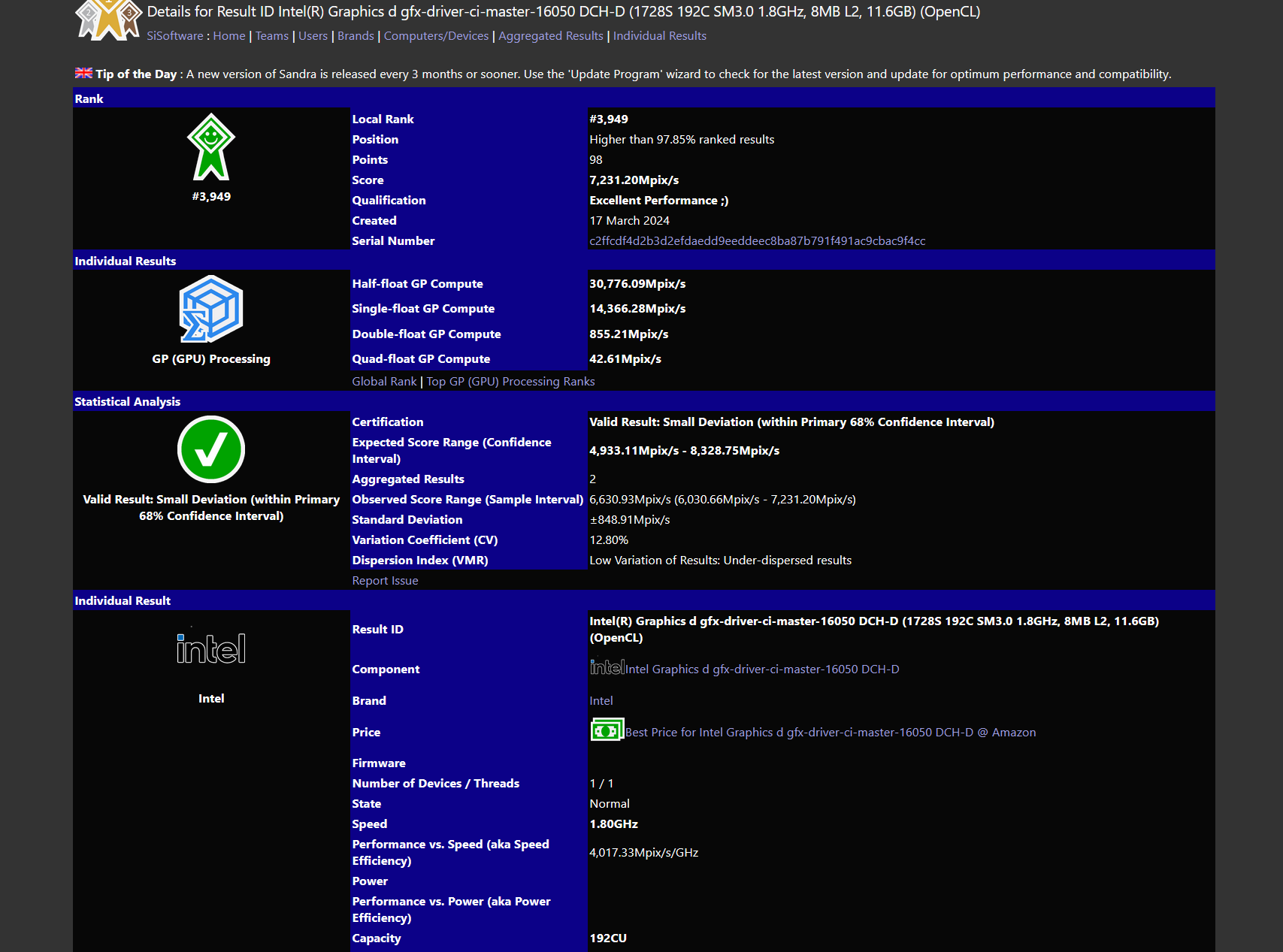
A pair of SiSoftware benchmark listings have unveiled two new Intel GPUs sporting 10 and 12 Xe cores, with 12GB of VRAM on both results. It's possible these two GPUs are future Battlemage graphics cards, though the relatively low clock speeds and limited core counts leave room for debate. They could also be alternative Alchemist configurations, faked listings, or even potential integrated graphics solutions. But let's talk about what we do know right now.
Battlemage is the upcoming successor to Arc Alchemist that will be targeted at the dedicated graphics card market. It will also be utilized as a future integrated graphics solution for Intel's future CPU architectures (including Lunar Lake). Intel is rumored to be targeting a Q3 2024 release date, which would line up well with this being a potential Battlemage leak.
According to the SiSoftware listings, the specs for both GPUs are seemingly unimpressive. The least-potent offering sports just 1440 shader ALUs, while the more potent SKU has 1728 shader ALUs. To put that in perspective, the Arc A580 has 3456 shaders, while the Arc A380 slashes that figure down to 1024 shaders. But there are some other curiosities to discuss. Depending on how many shaders are in each Xe-core, we end up with either 10 and 12 Xe-cores, or potentially 20 and 24 Xe-cores. Which answer is correct matters quite a lot, as we'll discuss below.
Clock speeds are also unimpressively low at just 1.8GHz, which admittedly could be due to early silicon and driver tests. The only somewhat higher spec is that both have 12GB of VRAM, which is better than the 8GB found on the A580 and A750 midrange GPUs. However, those cards use 1GB chips with a 256-bit interface, so it's still possible that these are Alchemist, just configured with 2GB chips and a 192-bit interface.
And then there's the 8MB of L2 cache. That's a bit of a weird number for a 12GB card, as Intel's Alchemist GPUs have had either 4MB or 2MB per 64-bit controller. The A750 and A770 both have 16MB of L2 cache while the A580 has 8MB, but it's not clear how chips with presumably a 192-bit interface could arrive at 8MB total cache — 2.67MB per 64-bit interface just doesn't seem likely, and such a small amount of L2 also doesn't make much sense for the future Battlemage architecture. Of course, the L2 cache could be decoupled from the memory interfaces, and Intel might have L3 cache that's not showing up in these "leaked" results, but we don't know for certain.


Compared to Intel's existing Arc Alchemist GPUs, these two GPUs offer rather low shader core counts — more than an Arc A380 but far less than an Arc A580. Note also that we can't rule out the possibility of these being early mobile chips for testing and debugging purposes. The system used shows an Intel Z790 motherboard, but it's possible to test mobile GPUs with a desktop if these leaks came from a hardware lab.
In terms of positioning, these appear to be budget to midrange graphics solutions, given the presumed Xe-core counts. We're also accepting SiSoftware's reported data at face value, which lists a 160 CU and 192 CU "capacity" with 1440 and 1728 "shaders." Intel doesn't use CU or Compute Units for its GPUs, as that's AMD, while Nvidia uses "Streaming Multiprocessors," but SiSoftware uses the same CU label for all three. These Intel GPUs seem to be using "CU multiplied by nine" for the shader figures, with the base CU number being 16 times the Xe-core count — or if you want to be old school, it's the Execution Unit counts from older Intel GPUs.
Clear as mud? Let's give a more concrete example with a known GPU configuration. This Arc A380 listing says 128 CU and 1152S. The actual Arc A380 has eight Xe-cores with 1024 shader ALUs spread among sixteen Vector Engines (formerly called Execution Units) per Xe-core. There's also one additional "special purpose" (extended math) ALU per Vector Engine. So, 8 * 16 * 9 = 1152 shader ALUs. But the same calculations from SiSoftware don't seem to apply to the larger Arc A-series GPUs for whatever reason (they use Xe-cores * 16 * 8, without factoring in the extended math ALU). Here's how things break down:
For now, the performance data isn't terribly helpful given we're unsure on some of the specs and how high Battlemage might go. The core configuration and clock speeds suggest performance will be better than an A380 — and it is. It also seems as though Intel is getting far more performance out of fewer shaders with these unknown GPUs.
By way of comparison, the Arc A580 OpenCL result of 6,121Mpix/s is about the same as the unknown 10 (or 20?) Xe-core chip's 6,031Mpix/s, but the A580 has 24 Xe-cores. And here's an Arc A750 OpenCL getting 7,145Mpix/s while this Arc A770 OpenCL result is 8,229Mpix/s — with the supposed 12 (or 24?) Xe-core GPU getting 7,231Mpix/s. Assuming the math is correct on shader counts, the unknown chips are easily beating similarly configured Alchemist GPUs.
These "new" GPUs land at the level of the A580 and A750, but with far fewer shaders, plus a different memory configuration. If these are Battlemage and can clock 40% higher than the 1.8GHz shown here, and then if we get chips with up to 32 Xe-cores and 4096 shaders, we would end up with a decent level of performance. Three times as many Xe-cores as the presumed 10-core GPU plus higher clocks would potentially put such an Intel chip into RTX 4070 Ti territory. But let's not get too carried away, as the cache and other specs still look odd, and the Xe-core numbers might actually be double what we used.
We've learned from both AMD and Nvidia that a bigger cache on a GPU can greatly improve performance. Intel has learned this as well, and while it was probably too late to add a big cache to Alchemist, we definitely expect Battlemage to come with bigger caches. 8MB doesn't cut it, though it may simply be that Intel has L3 cache and SiSoftware isn't querying or reporting that value.
Ultimately, it's too early to tell how fast Battlemage will be, but these supposed spec leaks look at least somewhat promising. If a 12 Xe-core chip at 1.8 GHz can already match the A750, and if Intel goes as high as 32 Xe-cores with Battlemage, we might actually be looking at reasonably competitive Intel solutions that could maybe take on the high-end AMD and Nvidia solutions. Maybe.
Alternatively, that's a 24 Xe-core Battlemage chip running at 1.8 GHz and matching a 2.4 GHz 28 Xe-core Alchemist chip. We already know where the A750 lands in our GPU benchmarks hierarchy, but while boosting clocks and performance by 50% would certainly help, that would still only result in something on the level of the RTX 3070, and slower than an RTX 4060 Ti. Let's hope this isn't the case.
Intel is already two years behind the competition, and with Intel confirming that Battlemage hardware development is already done and 70% of the team has moved on to Celestial — its GPU architecture after Battlemage — we're hoping these leaked results are for budget-oriented future GPUs and that substantially larger and faster variants are on the way. In the interim, the remaining 30% of Intel's graphics team is working on software and driver support for Battlemage, in preparation for its launch later this year.







